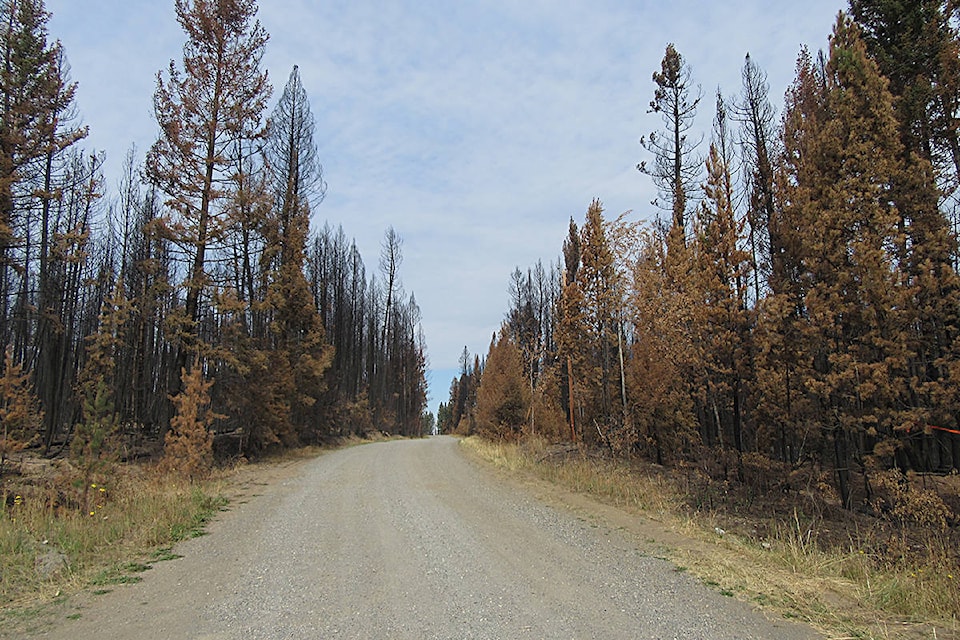Mills likely won’t be able to start logging burned crown land, including the Gustafsen area, until next summer, according to the Ministry of Forests, Lands, Natural Resource Operations and Rural Development (FLNRO).
“Areas burned that contain salvageable timber will be planned as salvage timber sales once field assessments, layout, stakeholder referral, consultation and other agency permissions are in place – currently anticipated by next summer.”
According to the statement, BC Timber Sales (BCTS) is evaluating options to auction timber impacted by the current wildfires on provincial land. Furthermore, any timber that was cut and decked from fire guard construction is undergoing expedited evaluation/development.
The schedule has sparked concerns on numerous fronts, including some burned wood going to waste and the destruction of any regrowth occurring this fall and spring.
“I would hope the Minister of FLNRO Doug Donaldson would expedite the salvageable timer asap. I would also hope he understands the shelf life of the burned timber is not long. Next summer to start salvage work is too long foresters have told me some fibre may only have a year. Time is of the essence let’s not waste what we can salvage,” says Cariboo-Chilcotin MLA Donna Barnett.
While it is more or less standard procedure, especially if there’s a delay, it means ecosystems get hit twice, says Phil Burton, professor of Ecosystem Science &Management at UNBC.
“There’s a downside to salvage logging from a biodiversity perspective in general in that a lot of ecosystems are sort of getting hit with a double whammy of impact in both the fire and the logging. So especially if there’s a delay, which there pretty much has to be, whether it’s just to let things cool or to let the planning and administrative process proceed, you’ll often have some forest regeneration and some recovery of plants and animals that then get hit again.”
There is some downside, however, to salvage logging in general says Burton.
“Most fires are rather mixed severity and there are surviving trees and surviving clumps that regenerate here and there that the standard salvage procedure is clear cut logging and so all of the green trees and what did survive is wiped out with the salvage operation unless there’s very specific instruction to leave them standing.”
Even then that’s counter to silviculture principles, says Burton. It’s also important to leave some trees for wildlife such as woodpeckers, he says.
Invasive species are a concern as well for burned areas in general as logging may aggravate that by having heavy machinery in the area, says Burton.
“[The right solution] is part of an ongoing discussion that’s talking about the need for more proactive planning in general and putting things in a zoning and landscape priority context. You don’t want to have one size fits all. Some areas that are near communities should probably be left as is without any salvage logging or any restoration or any replanting. Let’s leave them recover slowly over time and be prepared to go in there and thin them once we hit a dense crown of flammable fuels there again.
“Other areas that have higher priority for wildlife or biodiversity, again you might just want to leave while the third category of place might be where there might be an emphasis on timber production. There’s already good access. You don’t have to build roads that are slapped in with poor planning just to get the timber out.”
The decision has to be put in the long term planning and zoning context, says Burton.
Lori Daniels Associate Prof. Faculty of Forest and Conservation Sciences, UBC says now is a great time to do that planning.
The fires burned through areas where here was landscape level of fuel mitigation was planned, she says.
“We didn’t get to the point where those were implemented. They were planned for the next few years. I think reflecting back on those plans I mean those locations that were identified in the landscape as existing fuel breaks, natural fuel breaks that could be enhanced. Some of those locations still exist.
“As we look to the future, let’s think about that landscape level planning … Let’s figure out what we want our forests to look like next.”
Daniels says she’d like to hold off on logging to prevent making the same mistakes as elsewhere in the province with, for example, introducing invasive species being a concern.
